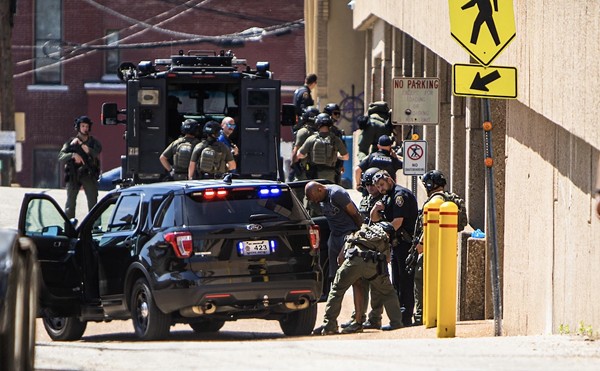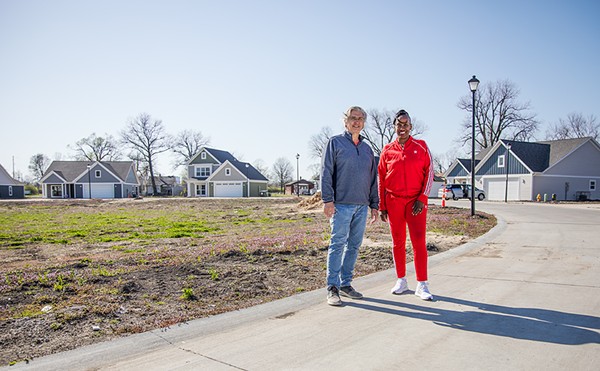Everyone signed on to the project -- except the Humane Society of Missouri. And without its support, the grant proposal to Maddie's Fund -- a foundation created by PeopleSoft co-founder Dave Duffield -- is doomed.
Last week, as the Humane Society continued to steadfastly refuse to support such an application, the controversy erupted on the television airwaves as a David-versus-Goliath battle pitting tiny Stray Rescue, a volunteer organization with just one paid staff member and an annual budget of about $100,000, against the behemoth that is the Humane Society of Missouri, which, with an endowment of more than $50 million, is one of the wealthiest humane organizations in the nation. Smaller animal-welfare organizations in the city are questioning the Humane Society's motives, and U.S. Rep. Lacy Clay (D-1st) has entered the fray, urging the Humane Society to reconsider its position in light of the recent death of Rodney McAllister, 10, who was fatally mauled by stray dogs. Clay called it "unconscionable" not to apply for the money. So far though, even the congressman's intervention hasn't helped.
Stray Rescue had been working on its proposal to Maddie's Fund for nearly two years. The fund, named after Duffield's miniature schnauzer, was given $200 million by Duffield and his wife, Cheryl, to spend making the country a "no-kill" nation. It awards multimillion-dollar, multiyear grants to community collaborative programs in exchange for a pledge that the project will find homes for all healthy, adoptable animals in the programs' designated area within a five-year period. The grantees must demonstrate a measurable impact on the problem on a quarterly and annual basis, and, in order to receive any money, the lead agency -- a no-kill organization -- must have the support of every animal-welfare organization in its designated area, which can be a city, county or state. Maddie's Fund also donates money to universities with veterinary colleges to help find ways to keep shelter pets healthier during longer stays and to veterinary associations to perform more spay/neuter surgeries.
Maddie's Fund president Richard Avanzino served as president of the San Francisco SPCA for years, a period during which the city went from having one of the highest euthanasia rates for any major city in the country to one of the lowest. Some 65,000 dogs and cats were euthanized annually 35 years ago, compared with about 2,000 today. He says the largest Maddie's Fund project to date is in the state of Utah. There, led by Best Friends, the largest animal sanctuary in the U.S., all 54 animal-control agencies, two shelters, 82 private veterinary hospitals and 22 no-kill organizations joined the statewide project, helped by a $1.3 million Maddie's Fund grant, which will ultimately total $8 million over five years. In its first six months, Avanzino says, adoptions increased 17 percent statewide and euthanasia figures declined by 9 percent.
Avanzino says it is up to the grantees to devise a strategy, but in Utah about 30 percent of the grant has been spent on advertising, promoting spay/neuter surgeries and adoptions, placing adoptable pets at shopping-mall locations and a mobile spay/neuter unit used to perform low-cost surgeries in rural areas. In its first two years, Maddie's Fund has awarded a total of $25 million in grants.
"The idea is that within a five-year period, not only do we get an adoption guarantee but we also grow the delivery system within the community," Avanzino says, "so they'll be successful in carrying out the goals in the future." If the projects receiving grants from part of the $200 million pot are successful in finding homes for healthy animals, he says, the foundation may receive another $800 million to spend on guaranteeing homes for sick, injured or behaviorally challenged animals.
Avanzino says all animal organizations in the area must support the project. "If we really want to have a community effort," he says, "we need to have community participation of the animal-welfare groups. It's been my experience that no group wants to kill an animal; everybody wants to save a life. We have found that groups we are funding, in spite of a history of disagreement or differing philosophies or different models, they are willing to put those things aside because they all agree on a common goal, which is to see the animals' lives get saved." That said, Avanzino adds, the bulk of the responsibility falls on the agency that receives the grant. A humane society, for example, is required only to turn over its euthanasia figures so that the progress of the grantee can be accurately measured in the community.
Melinda Bier, vice president of Stray Rescue, says her organization had hoped to reduce euthanasia rates by 3,000-5,000 dogs and cats annually. Though the proposal was preliminary, some of its strategies would have included a mobile spay/neuter clinic, a shuttle program to bring dogs and cats to other clinics in the county for spaying and neutering, neighborhood-based dog training and a public-education campaign that might include shows on local-access cable channels, parades and prominent spaces where animals could be adopted. In preparing the preliminary proposal, she called every animal organization in the city limits and was generally greeted with enthusiasm. The city Animal Regulation Center, and even the Animal Protective Association in the county, willingly shared their euthanasia figures. The Humane Society refused to do so, she says, and repeatedly rebuked attempts by Stray Rescue to enlist the Humane Society's help in the project.
"They simply don't understand [Maddie's Fund]. They never gave us an opportunity to come in and present our plan to them," she says. "We tried a number of approaches.... Their staff ignored our letters, did not return phone calls and treated us with a total lack of grace and professionalism."
Katherine McGowan, a spokeswoman for the Humane Society, says pursuing the grant "would be irresponsible and jeopardize the welfare of thousands of animals in St. Louis. The St. Louis community is in a situation where intractable problems prevent us from attaining the goals as they are outlined in the Maddie's Fund, that within a five-year time period we should reach the goal of becoming a no-kill region. Those goals, at this time, are unrealistic. It is irresponsible to pursue something that is not attainable."
As for releasing its euthanasia figures, McGowan says, the organization will only give them to Operation S.P.O.T. (Stop Pet Overpopulation Today). The group compiles euthanasia figures for the St. Louis metro area, but in order to secure the data, it agreed not to release data from each individual shelter or animal-control agency. It lumps together numbers by county or region. In 1999, for instance, nearly 40,000 cats and dogs were euthanized in the metro area.
The Humane Society has been slow to embrace changes and innovations implemented in cities such as San Francisco to stem pet overpopulation, as detailed in the Riverfront Times last year [Higgins, "High Society," Feb. 23, 2000]. Perhaps because of that stance, the St. Louis region has bucked a national trend and has watched its euthanasia rates climb by as much as 5 percent from 1994-98, even though it is home to one of the wealthiest humane societies in the country, with a new $11 million facility and an annual budget of more than $8 million. Its auxiliary offered to buy a mobile spay/neuter van for the Humane Society but was turned down. Its low-cost spay/neuter program resulted in only 62 such discount surgeries, out of 8,500 performed by the society in all of 1999. And up until it changed its policy in the last year, the Humane Society refused to perform early spay/neuter on puppies and kittens, allowing as many as 37 percent of its adopted animals to leave the shelter with reproductive organs intact. It hasn't endeared itself to other animal organizations in the past. When the Humane Society built its new headquarters, it rebuked a request by the city's Animal Regulation Center to purchase its old building, choosing instead to bulldoze it and build a $600,000 pet-memorial park with columns and a place to store the mementos of dead pets.
Other animal groups are openly critical of the Humane Society's position on the Maddie's Fund grant. "I think somebody should look at the number of animals they take in and euthanize," says Ray Feick, co-founder of Pound Pals, which finds homes for dogs at cats at the city's Animal Regulation Center. "Maybe that's the skeleton in their closet. I'm just very perplexed at their reluctance. All this nonsense that it's not workable is just absurd.
"These are things the Humane Society should be looking at. With all the money the Humane Society has, we shouldn't even have to be going out of state for funding," he adds.
Purebred Dog Rescue of St. Louis sent out is own press release: "To say that St. Louis is not ready for this money ... is a colossal insult to the St. Louis community as a whole."
Hilda Adams, acting health director for the St. Louis Health Department, says the city "fully supports" the grant application, even though the city would not receive any of those funds. "This is a community effort to address a very complex problem," she says. "It is a huge undertaking, and it's going to take a lot of work, and there is going to be pressure on community groups and the animal shelters. But unless we set a goal like this, we won't ever achieve it."
Randy Grim, president and founder of Stray Rescue, is frustrated to see the Humane Society quash an effort that could transform the city's landscape. "How many Rodney McAllisters will it take before the Humane Society is ready?" he asks. "She [McGowan] says it won't work. How do you know it won't work if you won't try?"





